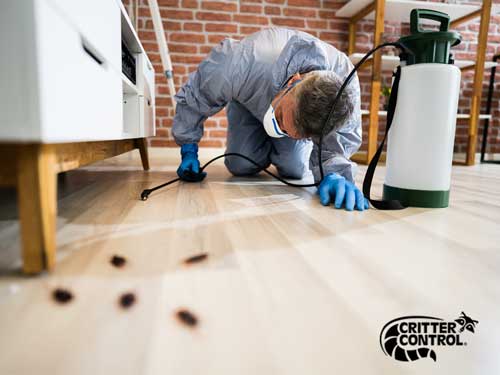Reputable A1 Bed Bug Exterminator Charlotte - Get Rid of Bed Bugs Rapid
Reputable A1 Bed Bug Exterminator Charlotte - Get Rid of Bed Bugs Rapid
Blog Article
Bed Bug Treatment Break Down: Comparing Chemical Vs. Non-Chemical Solutions
In the realm of parasite control, especially when taking care of the relentless concern of bed pests, the choice between chemical and non-chemical therapy services can be a crucial one. Both techniques offer distinct benefits and disadvantages, influencing aspects such as effectiveness, security factors to consider, and total cost. By analyzing the nuanced details of each approach, a clearer understanding of which path to pursue in addressing a bed pest problem can be achieved.
Performance of Chemical Therapies
Chemical therapies for bed pest invasions have been commonly recognized for their powerful and rapid effectiveness in eradicating these parasites. When thinking about the effectiveness of chemical treatments, it is crucial to comprehend that they can supply a quick and detailed solution to a bed bug trouble.
In addition, chemical treatments have the advantage of supplying residual results, implying that they can remain to eliminate bed pests even after the initial application. This recurring action is particularly valuable in combating any possible re-infestations. Furthermore, the rapid action of chemical treatments can bring alleviation to people facing serious bed insect invasions, allowing them to restore control of their home promptly.
Safety Worries With Chemical Solutions
One essential facet that requires mindful consideration when making use of chemical remedies for bed pest therapy is making certain the safety and security of passengers and the atmosphere. Exposure to specific chemicals utilized in bed bug treatments can lead to breathing concerns, skin irritation, or various other damaging reactions, particularly in individuals with pre-existing conditions or level of sensitivities.
Furthermore, the ecological influence of chemical solutions is another significant factor to consider. Some chemicals used in bed bug treatments may be dangerous to valuable bugs, wild animals, and communities if they leach right into the dirt or water systems. It is important to use chemical therapies deliberately, adhering to safety and security guidelines, and thinking about much less poisonous options to reduce these threats and guarantee the safe and reliable administration of bed insect invasions.
Benefits of Non-Chemical Methods
Taking into consideration the potential safety problems and environmental impact linked with chemical remedies for bed insect therapy, exploring non-chemical strategies provides an encouraging alternative with several distinctive advantages. Non-chemical methods use a safer option for houses, particularly those with people, youngsters, or pet dogs delicate to rough chemicals. These techniques eliminate the threats of direct exposure to toxic compounds, decreasing the possibility for damaging health and wellness results. Additionally, non-chemical therapies are eco friendly, as they do not add to air or water pollution, making them a lasting option for bug control.
Additionally, non-chemical solutions can be reliable in targeting bed bugs, consisting of hard-to-reach locations where chemical therapies may not penetrate. Techniques such as warmth treatment, vacuuming, vapor cleansing, and webpage cushion encasements give comprehensive removal without using dangerous chemicals. Moreover, non-chemical strategies can be much less disruptive, calling for minimal preparation and permitting quicker reentry right into dealt with areas. Generally, opting for non-chemical bed bug treatment methods not just focuses on security and ecological security yet also makes sure thorough and efficient insect control.
Limitations of Non-Chemical Treatments

Additionally, non-chemical treatments usually need multiple applications to achieve successful obliteration. This can be time-consuming and may not always ensure total see page elimination of all bed insects and their eggs, particularly in hidden or hard-to-reach places.
In addition, the success of non-chemical treatments heavily counts on correct application and thoroughness, which can be challenging for people without professional knowledge. Inadequate application of non-chemical approaches may result in incomplete obliteration, leading to consistent invasions and the demand for added therapies.
As a result, while non-chemical therapies have their benefits, it is vital to acknowledge these constraints and consider them when identifying the most efficient approach for managing bed pest problems.
Expense Contrast: Chemical Vs. Non-Chemical Options
Offered the constraints connected with non-chemical treatments, an essential facet to examine in the context of bed bug monitoring is the cost contrast in between chemical and non-chemical choices. In contrast, non-chemical therapies like warm therapy official source or vapor can be a lot more pricey, with costs ranging from $1,000 to $6,000 for an entire home. While the preliminary expense of chemical therapies might appear reduced, several therapies may be called for to totally eliminate the invasion, possibly enhancing the total expense.
Conclusion

Considering the potential safety issues and ecological impact linked with chemical solutions for bed pest treatment, checking out non-chemical strategies presents an encouraging option with numerous distinctive benefits.Given the limitations connected with non-chemical therapies, a vital element to review in the context of bed bug management is the expense contrast in between chemical and non-chemical options. In contrast, non-chemical therapies like heat treatment or heavy steam can be a lot more costly, with expenses varying from $1,000 to $6,000 for a whole home. While the first price of chemical therapies might seem lower, several therapies may be called for to fully remove the infestation, possibly raising the general expense.In verdict, when contrasting chemical and non-chemical bed bug treatment choices, it is vital to think about efficiency, safety, advantages, constraints, and price.
Report this page